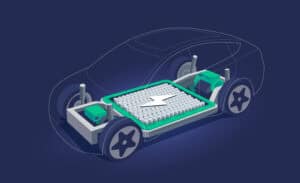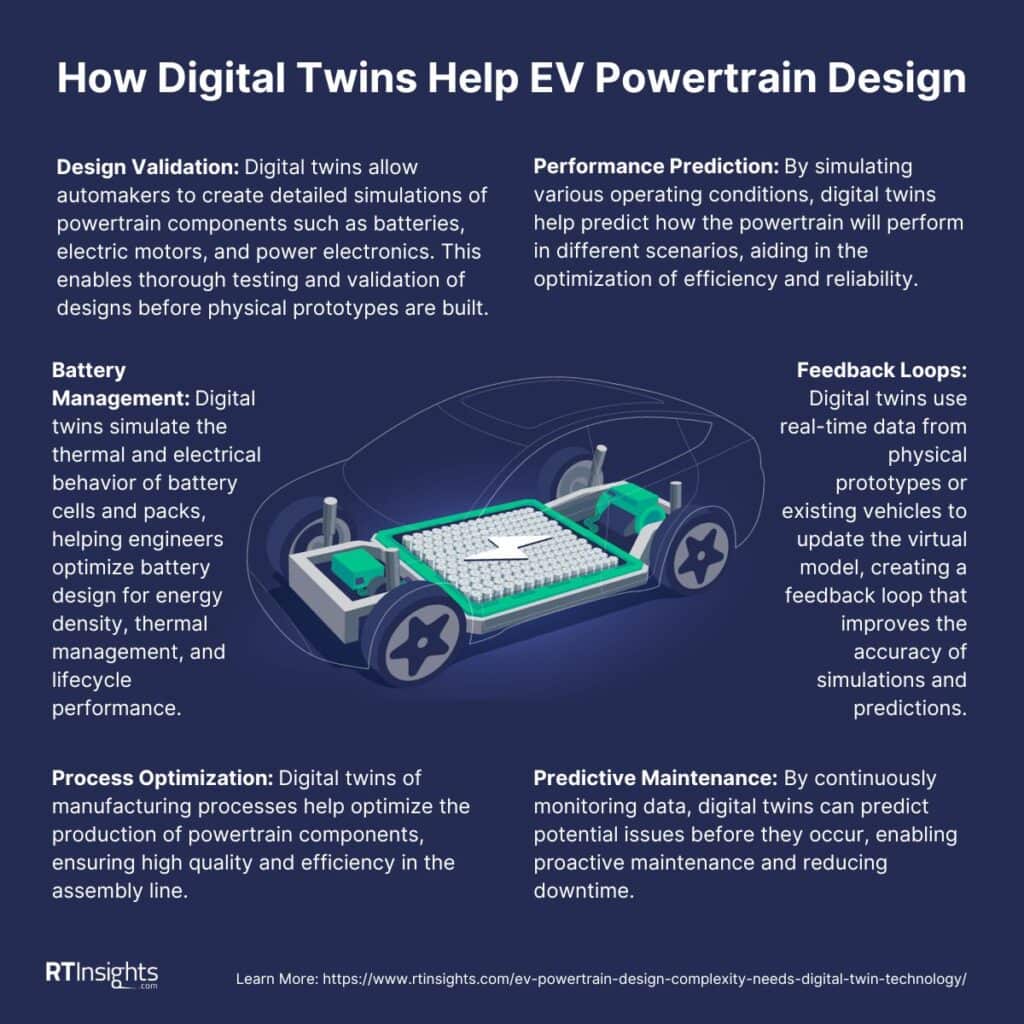
By using digital twins, automakers can enhance the precision, efficiency, and speed of EV powertrain development, leading to better-performing, more reliable, and cost-effective electric vehicles.
The complexity of electric vehicle (EV) powertrains requires a multidisciplinary approach and advanced engineering solutions to create efficient, reliable, and high-performing electric vehicles. Increasingly, automakers are turning to digital twin technology to address the design challenges and speed the development of new EVs.
They will need to do this sooner, rather than later as the market is expected to grow quickly. To that point, the global electric powertrain market size was valued at $83.30 billion in 2022 and is expected to increase at a compound annual growth rate (CAGR) of 15.3% through 2030, according to Grand View Research.
A quick look at the issues automakers encounter when trying to design powertrains for EVs shows the need for digital twin technology that allows frequent design iterations fueled by real world data.
At the heart of the problem is that when developing a new EV, companies must address several powertrain design challenges to ensure efficiency, performance, reliability, and cost-effectiveness. Some of the key challenges are:
Battery Technology Issues
Designers must address energy density issues. Specifically, they need batteries with higher energy density to extend the driving range without significantly increasing the weight and size of the battery pack. Additionally, they must develop batteries withfast-charging capabilities without degrading the battery’s lifespan. They must also ensure that there are efficient cooling and heating systems to maintain optimal battery performance and safety.
Electric Motor Design Issues
EV automakers must design motors that offer high efficiency across a wide range of operating conditions. They also must createmotors that provide high power output relative to their size and weight. And they need to address thermal management so that heat generated by the motor does not lead to overheating or degrade the motor’s performance.
Power Electronics Issues
Designers must develop new, highly efficient inverters and converters to manage power flow between the battery, motor, and additional systems. The high energy generation and consumption require that an EV powertrain has an advanced thermal management system to ensurepower electronics can dissipate heat effectively to avoid overheating and maintain efficiency. All these design elements naturally must take cost into account.
Integration and Packaging Issues
EV powertrains bring together elements that many automakers have not typically worked with. Gaining expertise in the individual components is still not enough. The battery, motor, and power electronics must all be brought together in a manner that optimizes space and weight distribution within the vehicle. And because there is so much variability and frequent changes in what customers want, it is essential that an EV manufacturer design modular components that can be easily adapted for different vehicle models and configurations.
Thermal Management Issues
EV manufacturers must develop systems that maintain the battery within its optimal temperature range under various operating conditions. Additionally, powertrain design must ensure motors and power electronics are effectively cooled to maintain performance and longevity.
Cost and Manufacturing Issues
Several factors must be addressed to keep costs under control and ensure that manufacturing operations run smoothly. So, as they must do for their combustion engine cars, EV manufacturers must closely monitor, account for, and manage the cost of raw materials, particularly for batteries and power electronics. Additionally, they must develop manufacturing processes that can be scaled up efficiently for mass production. They must also ensure a reliable supply chain for critical components, especially given the global demand for EVs.
See also: Smart Manufacturing Essential for the Transition to EVs
How Digital Twin Technology Helps
Addressing these challenges requires a multidisciplinary approach involving expertise in materials science, electrical engineering, mechanical engineering, software development, and manufacturing processes.
As such, automakers are increasingly leveraging digital twins to design electric vehicle (EV) powertrains. Utilizing digital twin technology for EV powertrain design helps in the following ways:
Simulation and Modeling
- Design Validation: Digital twins allow automakers to create detailed simulations of powertrain components such as batteries, electric motors, and power electronics. This enables thorough testing and validation of designs before physical prototypes are built.
- Performance Prediction: By simulating various operating conditions, digital twins help predict how the powertrain will perform in different scenarios, aiding in the optimization of efficiency and reliability.
Optimization of Components
- Battery Management: Digital twins simulate the thermal and electrical behavior of battery cells and packs, helping engineers optimize battery design for energy density, thermal management, and lifecycle performance.
- Motor Efficiency: Electric motor designs can be refined by simulating electromagnetic and thermal characteristics, leading to motors that are more efficient and have better power density.

Real-Time Data Integration
- Feedback Loops: Digital twins use real-time data from physical prototypes or existing vehicles to update the virtual model, creating a feedback loop that improves the accuracy of simulations and predictions.
- Predictive Maintenance: By continuously monitoring data, digital twins can predict potential issues before they occur, enabling proactive maintenance and reducing downtime.
Virtual Testing and Prototyping
- Cost Reduction: Virtual testing through digital twins reduces the need for multiple physical prototypes, significantly cutting down development costs and time.
- Safety Testing: Simulations can test the safety of powertrain components under extreme conditions, ensuring they meet safety standards without the risks associated with physical testing.
Integration and System-Level Analysis
- System Dynamics: Digital twins allow automakers to analyze the interactions between different powertrain components, such as how the battery and motor work together under various driving conditions.
- Energy Management: By simulating the entire powertrain system, digital twins help optimize energy management strategies, improving range and efficiency.
Manufacturing and Quality Control
- Process Optimization: Digital twins of manufacturing processes help optimize the production of powertrain components, ensuring high quality and efficiency in the assembly line.
- Defect Detection: Real-time monitoring and simulation of the manufacturing process can identify potential defects early, allowing for corrective actions before they impact the final product.
Customization and Personalization
- Tailored Solutions: Automakers can use digital twins to develop customized powertrain solutions for different vehicle models, markets, or customer preferences, ensuring optimal performance for specific use cases.
- Customer Feedback: Data from vehicles in use can be fed back into digital twins to continuously improve and tailor powertrain designs based on real-world performance and customer feedback.
Collaboration and Communication
- Interdisciplinary Collaboration: Digital twins provide a common platform for engineers, designers, and other stakeholders to collaborate, share insights, and make informed decisions.
- Stakeholder Communication: Visualizations and simulations from digital twins can effectively communicate design choices and performance metrics to non-technical stakeholders, such as executives and investors.
Lifecycle Management
- End-of-Life Analysis: Digital twins can simulate the entire lifecycle of powertrain components, helping in the design of recycling and reuse strategies to reduce environmental impact.
- Continuous Improvement: As new data is collected over time, digital twins can be updated to reflect the latest performance and usage trends, guiding ongoing improvements and next-generation designs.
See also: The Value of Vehicle Electrification
By using digital twins, automakers can enhance the precision, efficiency, and speed of EV powertrain development, leading to better-performing, more reliable, and cost-effective electric vehicles.







